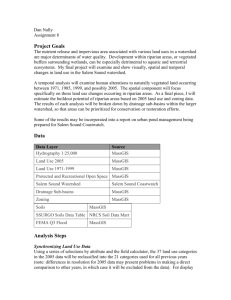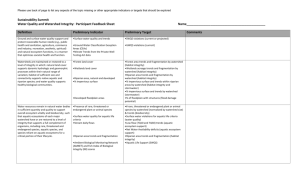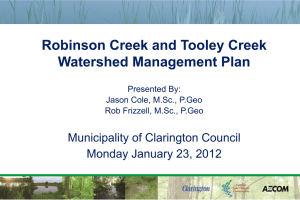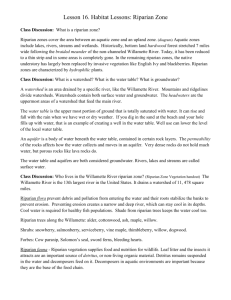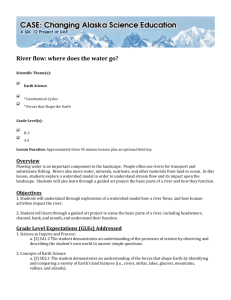Assignment_6
advertisement
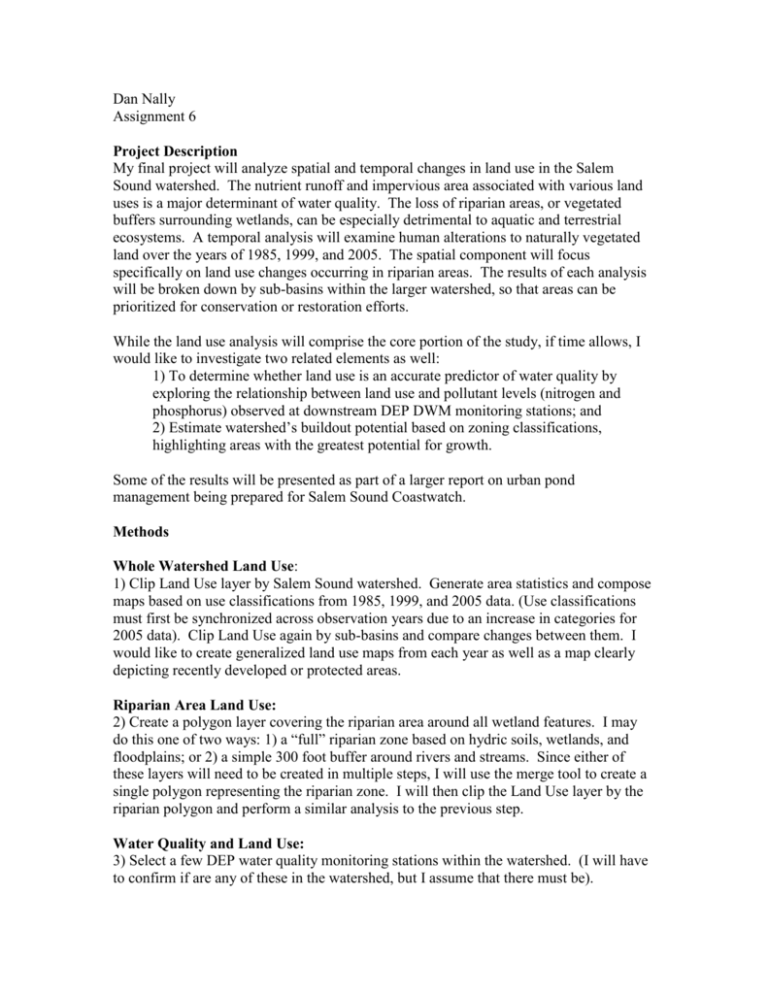
Dan Nally Assignment 6 Project Description My final project will analyze spatial and temporal changes in land use in the Salem Sound watershed. The nutrient runoff and impervious area associated with various land uses is a major determinant of water quality. The loss of riparian areas, or vegetated buffers surrounding wetlands, can be especially detrimental to aquatic and terrestrial ecosystems. A temporal analysis will examine human alterations to naturally vegetated land over the years of 1985, 1999, and 2005. The spatial component will focus specifically on land use changes occurring in riparian areas. The results of each analysis will be broken down by sub-basins within the larger watershed, so that areas can be prioritized for conservation or restoration efforts. While the land use analysis will comprise the core portion of the study, if time allows, I would like to investigate two related elements as well: 1) To determine whether land use is an accurate predictor of water quality by exploring the relationship between land use and pollutant levels (nitrogen and phosphorus) observed at downstream DEP DWM monitoring stations; and 2) Estimate watershed’s buildout potential based on zoning classifications, highlighting areas with the greatest potential for growth. Some of the results will be presented as part of a larger report on urban pond management being prepared for Salem Sound Coastwatch. Methods Whole Watershed Land Use: 1) Clip Land Use layer by Salem Sound watershed. Generate area statistics and compose maps based on use classifications from 1985, 1999, and 2005 data. (Use classifications must first be synchronized across observation years due to an increase in categories for 2005 data). Clip Land Use again by sub-basins and compare changes between them. I would like to create generalized land use maps from each year as well as a map clearly depicting recently developed or protected areas. Riparian Area Land Use: 2) Create a polygon layer covering the riparian area around all wetland features. I may do this one of two ways: 1) a “full” riparian zone based on hydric soils, wetlands, and floodplains; or 2) a simple 300 foot buffer around rivers and streams. Since either of these layers will need to be created in multiple steps, I will use the merge tool to create a single polygon representing the riparian zone. I will then clip the Land Use layer by the riparian polygon and perform a similar analysis to the previous step. Water Quality and Land Use: 3) Select a few DEP water quality monitoring stations within the watershed. (I will have to confirm if are any of these in the watershed, but I assume that there must be). Determine if land use in contributing areas correlate with higher nitrogen and phosphorus levels downstream. Contributing areas may be determined by: 1) Using the DEM Elevelation Layer: create and Flow Direction layer with filled Sinks Use the Watershed Tool with DEP sites as pour points to delineate the contributing area of each; or 2) More simply, but less accurate, choose one monitoring site per sub-basin. Buildout Analysis (whole watershed) 4) Clip zoning by Salem Sound watershed. Using the Land Use/Zoning Crosswalk method referred to on the MassGIS website (http://www.mass.gov/mgis/landuse_stats.htm), and discussed in more detail at (http://commpres.env.state.ma.us/content/buildout.asp) to aggregate land use and zoning into a single layer showing maximum potential buildout. Determine what uses unprotected open land could become in the future. Examples of Similar Studies Ekness, P., Randhir, T. (2007). Effects of Riparian Areas, Stream Order, and Land Use Disturbance on Watershed-Scale Habitat Potential: An Ecohydrologic Approach to Policy. Journal of the American Water Resources Association, 43 (6), 1468-1482. Ekness and Randhir examined spatial-temporal relationships between water resources and the quality of the surrounding habitat in the Westfield watershed in Western Massachusetts. A GIS analysis based on GAP data for species diversity and MassGIS land use datalayers showed that habitat potential is highest in riparian zones, headwater areas, and lower order subwatersheds. The article posits that water quality improvements can be made more efficiently through conservation policies that encourage wider and variable width riparian zones, protect headwaters and lower order subwatersheds, and minimize disturbances in riparian/headwater areas. Haag, S.M., Lathrop, R.G., (2007). Assessment of Land Use Change and Riparian Zone Status in Barnegat Bay and Little Egg Harbor Watershed: 1995-2002-2006. I plan to use this report as the primary model for my project. Haag and Lathrop used land use data from 1995, 2002, and 2006 to monitor the development of riparian areas in the Little Egg Harbor Watershed in New Jersey. The land use analysis used two measures of riparian zones: 1) a “full” riparian zone based on hydric soils, wetlands, and floodplains; and 2) a simple 300 foot buffer around rivers and streams. Results of the analysis were broken down by sub-basins allowing them to be prioritized by for remedial action. Massachusetts Audubon Society. (2009). Losing Ground: Beyond the Footprint. Retrieved from http://www.massaudubon.org/losingground/download.php Mass Audubon performed a thorough statewide land use study illustrating the ecological impacts of sprawl and the need prioritize and coordinate protection efforts on a regional scale. The report’s s content is effectively displayed by a number of fantastic GIS figures. Sliva, L., Williams, D. D. (2001). Buffer Zone Versus Whole Catchment Approaches to Studying Land Use Impact on River Water Quality. Journal of Water Resources, 35 (14), 3462-3472. Sliva and Williams evaluated the effects of natural and anthropogenic landscape characteristics on water quality in Ontario watersheds. The study sought to determine whether land use near streams is a better predictor of water quality than land use throughout the entire watershed. The results showed that in both cases, urban land use was the strongest determinant of water quality. Also, whole watershed landscape characteristics afforded slightly greater predictability than a buffer zone analysis. Data Layers Data Layer Source Hydrography 1:25,000 Land Use 2005 Land Use 1991-1955 Soils Impervious Surface Protected and Recreational Open Space DEP DWM Monitoring Stations DEP DWM Related Water Quality Tables Digital Elevation Model 1:5,000 Salem Sound Watershed Drainage Sub-basins Zoning MassGIS MassGIS MassGIS MassGIS MassGIS MassGIS Minimum Accepted Accuracy* (feet) 100 100 100 100 100 100 MassGIS general area MassGIS n/a MassGIS 10 Salem Sound Coastwatch MassGIS MassGIS 200 200 100 * Except where otherwise noted, a minimum accuracy of 100 feet is preferred. Since the analysis is being performed over a large study area, absolute precision is not required. 100 feet was chosen because this is the width of a typical regulated buffer zone around wetlands.
